Sky-high camera angles elevate your cinematography by offering unique perspectives that captivate viewers. You'll create stunning visuals by mastering altitude ranges, from intimate low shots to grand high-altitude reveals. Dynamic movement techniques, like smooth pans and sweeping arcs, transform static images into immersive sequences. Composition from above requires rethinking traditional framing, utilizing leading lines and symmetry. Lighting considerations, especially during golden hours, enhance the mood and texture of your shots. By revealing hidden spatial relationships and amplifying terrain's visual impact, you'll tell powerful stories that evoke awe and wonder. The journey to cinematic aerial mastery is just beginning to unfold.
Mastering Altitude for Impact
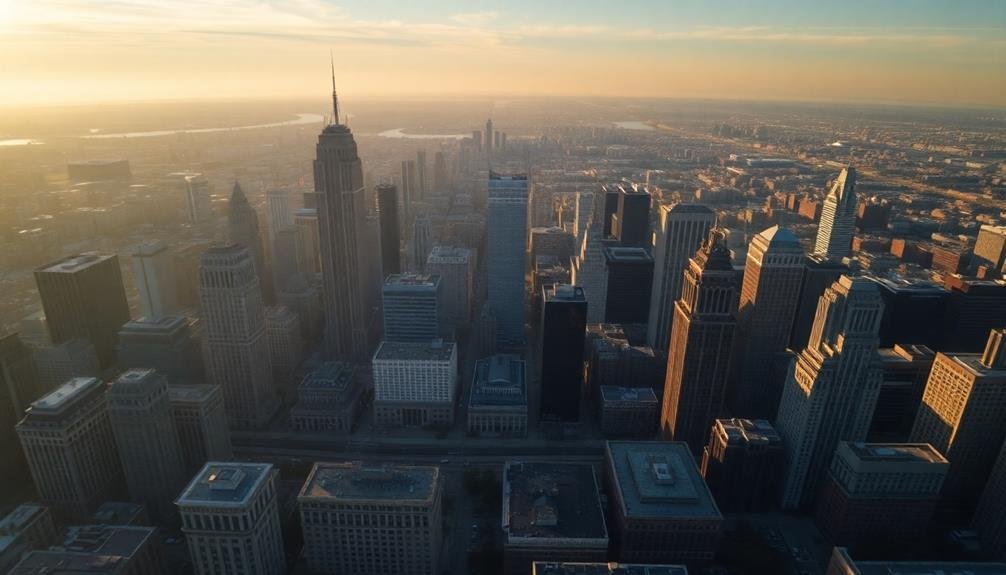
Mastering altitude is key to creating impactful aerial shots. You'll need to experiment with different heights to find the sweet spot for your scene.
Low altitudes, around 10-50 feet, can create a sense of intimacy while still offering a unique perspective. They're great for following subjects or revealing landscapes gradually.
Mid-range altitudes, from 50-400 feet, offer versatility. You can capture sweeping vistas, track vehicles, or showcase architectural details. At this height, you'll strike a balance between detail and context.
High altitudes, above 400 feet, are perfect for establishing shots and grand reveals. They can make even familiar locations look alien and awe-inspiring. However, be mindful of local regulations and flight restrictions at these heights.
Consider the emotional impact of your altitude choice. Lower shots feel more personal and immersive, while higher ones can evoke feelings of isolation or insignificance.
Match your altitude to the mood you're trying to convey.
Dynamic Movement in Aerial Shots
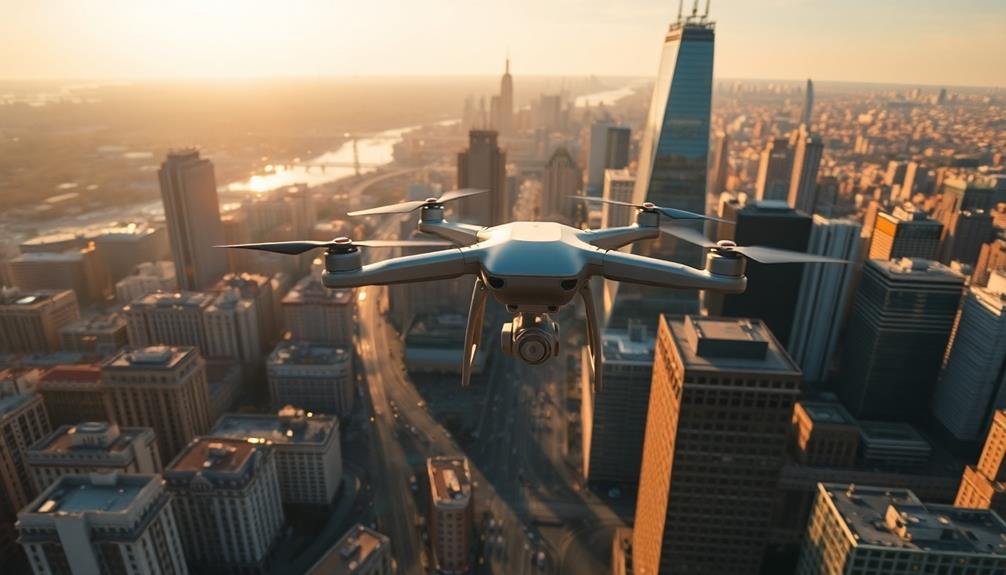
Through dynamic movement, aerial shots can transform from static images into enchanting, fluid sequences. You'll find that incorporating motion into your sky-high camera angles adds depth and dimensionality to your footage.
Start by mastering smooth, controlled movements like pans, tilts, and tracking shots. These techniques allow you to reveal landscapes gradually, building anticipation and guiding the viewer's eye.
Don't shy away from more complex movements. Try combining multiple motions, such as a sweeping arc paired with a gentle descent. This creates a sense of vertigo and immersion that can't be achieved with stationary shots.
Experiment with speed variations too. A slow, majestic reveal can evoke awe, while rapid movements can inject energy and excitement into your scene.
Composition From Above
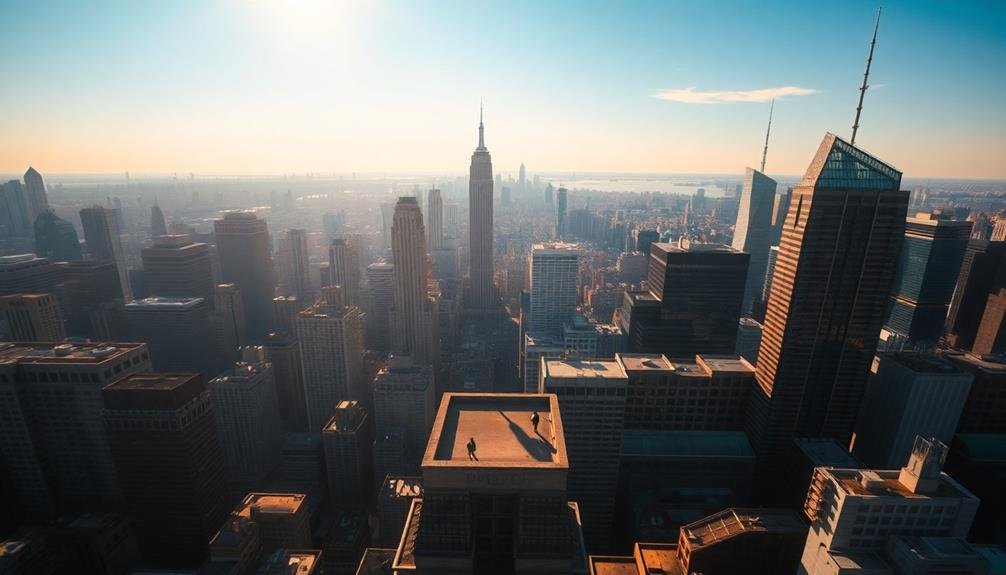
Aerial composition rules take on a new dimension when you're shooting from above. You'll need to rethink traditional framing techniques and embrace a new perspective. From this vantage point, patterns and geometric shapes become more pronounced, offering unique visual opportunities.
When composing your shot, look for leading lines that guide the viewer's eye through the frame. Roads, rivers, and architectural features can create compelling visual paths. Pay attention to symmetry and balance, as they're often more apparent from above. You can use natural or man-made elements to divide your frame into interesting sections.
Color contrast becomes essential in aerial composition. Look for striking differences between land and water, urban and rural areas, or seasonal changes in vegetation. Shadows cast by buildings or landscape features can add depth and texture to your shots.
Consider the scale of your subject matter. Juxtapose small objects against vast landscapes to create a sense of awe or isolation. Alternatively, fill the frame with repetitive patterns for a more abstract approach.
Remember to adjust your camera settings for aerial conditions. Faster shutter speeds will help combat camera shake, ensuring crisp, clear images that truly capture the grandeur of the sky-high perspective.
Lighting Considerations for Drone Cinematography
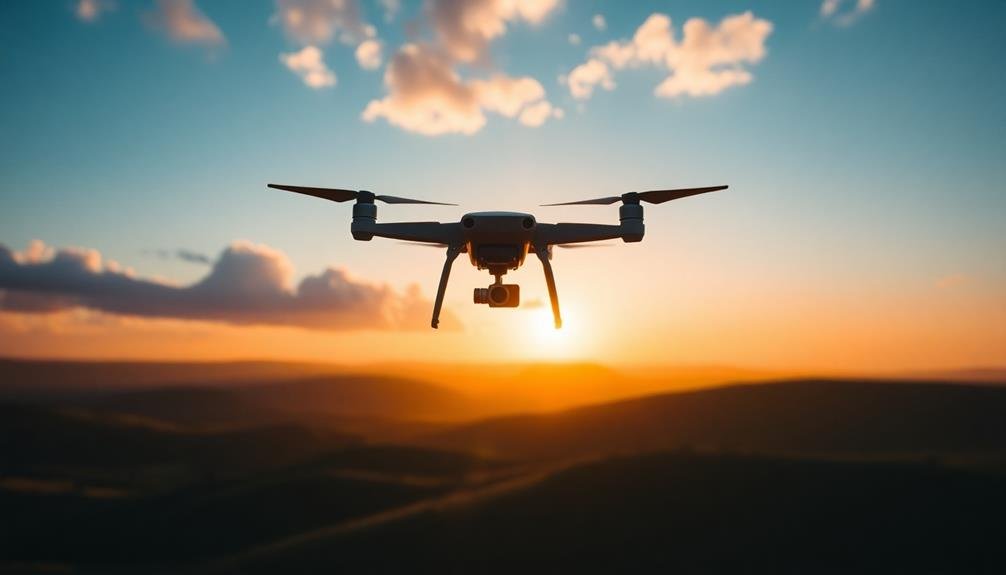
Lighting plays a pivotal role in drone cinematography, shaping the mood and quality of your aerial footage. When shooting from above, you'll need to take into account how sunlight interacts with your subject and surroundings.
The golden hours—just after sunrise and before sunset—offer warm, soft light that can create stunning visuals. However, you'll need to work quickly as these periods are brief.
Midday sun can be harsh, creating strong shadows and high contrast. To mitigate this, use ND filters to control exposure and maintain a cinematic look.
Overcast days provide diffused light, ideal for even illumination but potentially lacking drama. In these conditions, look for interesting textures and patterns in landscapes.
When filming at night, city lights can create mesmerizing patterns, but you'll need to adjust your camera settings for low-light conditions. Increase ISO cautiously to avoid noise, and use slower shutter speeds to capture more light.
Remember, drones have limitations in low light, so plan accordingly.
Take into account the direction of light relative to your drone's position. Backlit scenes can create silhouettes and lens flares, while side-lighting can enhance textures and depth.
Always monitor your histogram to ascertain proper exposure across your frame.
Revealing Landscapes Through Perspective
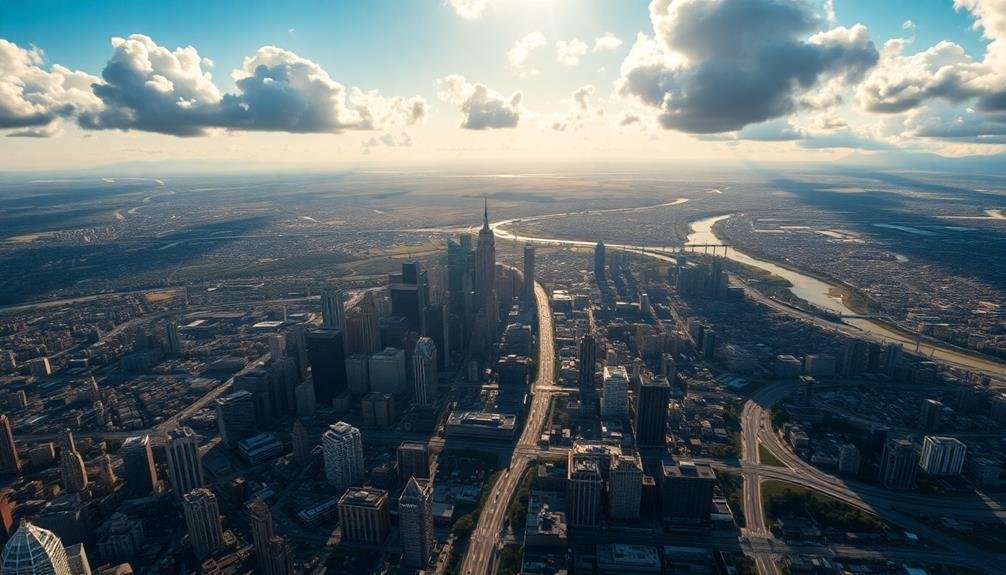
You'll uncover hidden spatial relationships when shooting landscapes from above.
Aerial perspectives can reveal connections between natural features that aren't apparent from the ground.
Unveiling Hidden Spatial Relationships
When you soar high above the ground, hidden spatial relationships in landscapes begin to disclose themselves. From this vantage point, you'll notice patterns and connections that aren't visible from ground level.
Rivers snake through valleys, forming intricate networks that shape the land. Urban sprawl becomes a tapestry of geometric shapes, disclosing the logic behind city planning and development.
You'll see how natural features influence human settlements, with towns nestled in protective valleys or strung along coastlines. Agricultural patterns emerge, showcasing the interplay between topography and land use.
Forest boundaries and deforestation become starkly apparent, highlighting environmental changes over time.
Sky-high angles also reveal the true scale of landscapes. Massive geological formations dwarf nearby structures, while seemingly vast urban areas shrink in comparison to surrounding wilderness.
You'll gain a new appreciation for the delicate balance between human activity and nature.
These elevated perspectives allow you to comprehend spatial relationships on a macro level, offering insights into how different elements of a landscape interact and influence each other.
Amplifying Terrain's Visual Impact
Sky-high camera angles dramatically amplify the visual impact of terrain, transforming ordinary landscapes into breathtaking vistas. When you elevate your camera, you'll reveal the true scale and grandeur of the environment, exposing patterns and textures that remain hidden from ground level.
From above, you'll capture the intricate interplay of light and shadow across vast expanses, highlighting the contours of mountains, valleys, and coastlines. You'll showcase the serpentine paths of rivers, the patchwork of fields, and the sprawl of urban developments in ways that ground-level shots simply can't match.
Aerial perspectives allow you to emphasize the relationship between different landscape elements. You'll reveal how forests give way to meadows, how cities blend into surrounding countryside, and how geological features shape the land. By adjusting your height and angle, you can control the balance between foreground and background, creating depth and leading the viewer's eye across the scene.
Moreover, sky-high angles often evoke a sense of awe and wonder, reminding viewers of nature's immensity and beauty. They can turn familiar locations into abstract compositions, offering fresh, enchanting perspectives on well-known landscapes.
Storytelling With Bird's-Eye Views
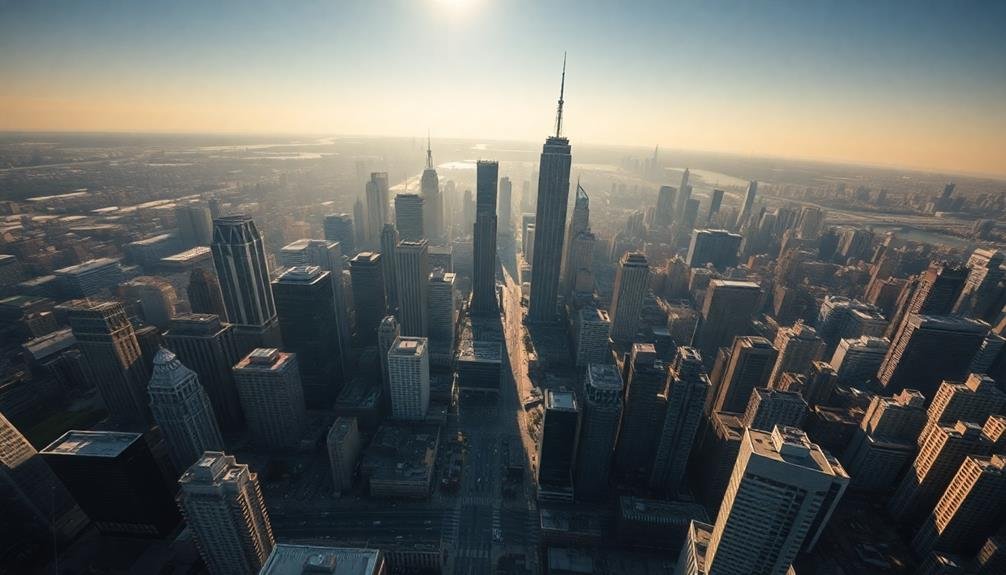
How can a bird's-eye view transform your storytelling? By offering a unique perspective that's impossible to achieve at ground level, you'll instantly capture your audience's attention and provide context that enhances your narrative.
This elevated angle allows you to reveal relationships between characters, objects, or locations that might otherwise remain hidden.
Use bird's-eye views to establish the scale of your setting, whether it's a sprawling cityscape or a vast natural landscape. You can create a sense of isolation by showing a lone figure dwarfed by their surroundings, or convey the bustling energy of a crowded space.
These shots are particularly effective for shifts, helping you move seamlessly between scenes or time periods.
Don't overlook the emotional impact of bird's-eye views. They can evoke feelings of vulnerability, insignificance, or awe in your audience.
Technical Aspects of High-Altitude Filming
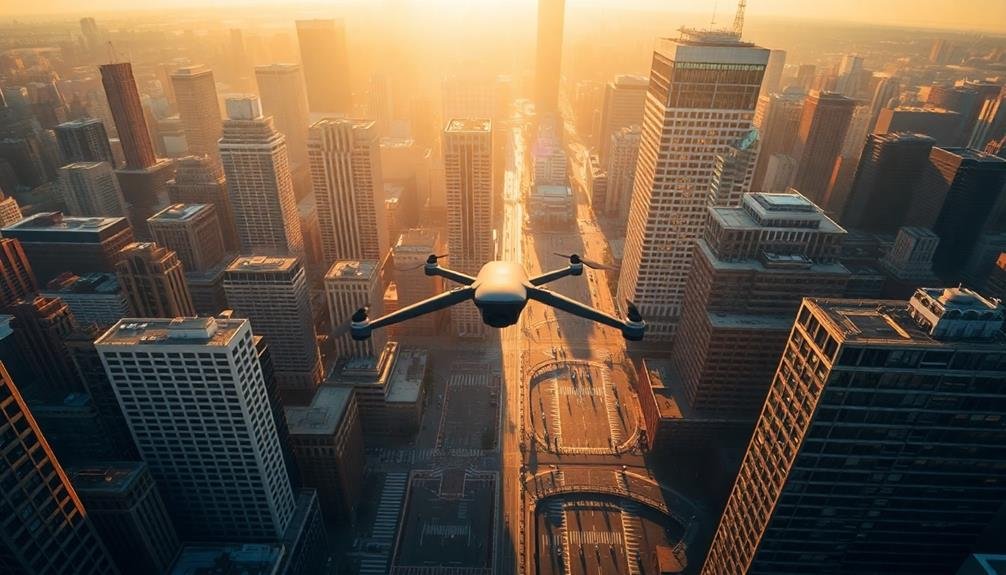
Mastering the technical aspects of high-altitude filming is vital for capturing stunning aerial shots. You'll need to take into account several key factors to achieve professional-quality results.
First, choose the right equipment. High-end drones or helicopters equipped with stabilized camera systems are essential for smooth footage. Make sure your camera has a wide dynamic range to handle varying light conditions at altitude.
Weather plays a significant role in high-altitude filming. You'll need to monitor wind speeds, cloud cover, and visibility. Clear days offer the best visibility, but overcast conditions can create dramatic atmospheres. Be prepared to adjust your shooting schedule based on weather forecasts.
Camera settings are critical. Use a fast shutter speed to minimize motion blur, and opt for a lower ISO to reduce noise. Wide-angle lenses are often preferred for expansive views, but telephoto lenses can create compelling compositions of distant subjects.
Post-production is equally important. Color grading can enhance the unique lighting conditions of high-altitude shots. Use stabilization software to further smooth any remaining camera shake.
Weather and Environmental Challenges

When you're filming from high altitudes, you'll face several weather-related obstacles.
You'll need to contend with turbulence and maintain camera stability while battling unpredictable visibility and lighting conditions.
It's essential to implement robust equipment protection measures to shield your gear from extreme temperatures, moisture, and atmospheric pressure changes.
Turbulence and Stability Issues
Capturing breathtaking aerial shots isn't always smooth sailing. When you're dealing with sky-high camera angles, turbulence and stability issues can quickly become your biggest nemesis. Wind gusts, air pockets, and atmospheric disturbances can cause your drone or helicopter to shake, sway, or suddenly drop, compromising the quality of your footage.
To combat these challenges, you'll need to invest in advanced stabilization technology. Gimbals are essential for keeping your camera level and steady, counteracting the pitch, roll, and yaw of your aerial platform. High-quality drones often come equipped with built-in stabilization systems, but for more demanding shoots, you might opt for additional external stabilizers.
You'll also want to master the art of smooth piloting. Practice flying in various weather conditions to improve your control and anticipate turbulence. When possible, plan your shoots during calmer parts of the day, typically early morning or late evening.
Don't forget to adjust your camera settings, opting for faster shutter speeds to minimize motion blur. By addressing these stability issues head-on, you'll guarantee your sky-high shots maintain that cinematic quality audiences crave.
Visibility and Lighting Conditions
While stabilizing your aerial shots is essential, you'll face another set of challenges when it comes to visibility and lighting conditions. Weather and environmental factors can greatly impact your sky-high camera work.
You'll need to contend with changing cloud cover, which can affect light intensity and create unpredictable shadows. Haze and atmospheric pollution can reduce clarity and contrast in your shots, especially when filming from great heights.
Wind speed and direction will influence not only your drone's stability but also the movement of clouds, creating dynamic backgrounds that may or may not suit your artistic vision.
You'll need to evaluate the sun's position carefully, as lens flare and glare can be more pronounced at altitude. Golden hour and blue hour take on new dimensions when shooting from above, offering unique lighting opportunities but also presenting timing challenges.
Precipitation, from light mist to heavy rain, can obstruct your camera's view and potentially damage equipment. You'll need to monitor weather forecasts closely and be prepared to adjust your shooting schedule or equipment setup accordingly.
Equipment Protection Measures
During sky-high camera work, protecting your equipment from harsh environmental conditions is crucial.
You'll face challenges like extreme temperatures, moisture, dust, and wind that can damage your gear and compromise your footage. Invest in waterproof and shockproof cases for your cameras, lenses, and accessories to shield them from the elements.
Use lens filters to protect your glass from scratches and debris while maintaining image quality. UV filters can reduce haze in high-altitude shots. Don't forget to bring lens cleaning supplies to remove any dust or smudges quickly.
For drones, consider propeller guards to protect the blades from impacts. Make sure your drone has a robust GPS system and return-to-home function in case of signal loss. Carry spare batteries and keep them warm in cold conditions to maintain their charge.
When working with cranes or jibs, secure all equipment tightly and use safety cables as a backup. Weather-sealed cameras are ideal, but if you're using non-sealed gear, bring rain covers or plastic bags for unexpected showers.
Post-Production Techniques for Aerial Footage
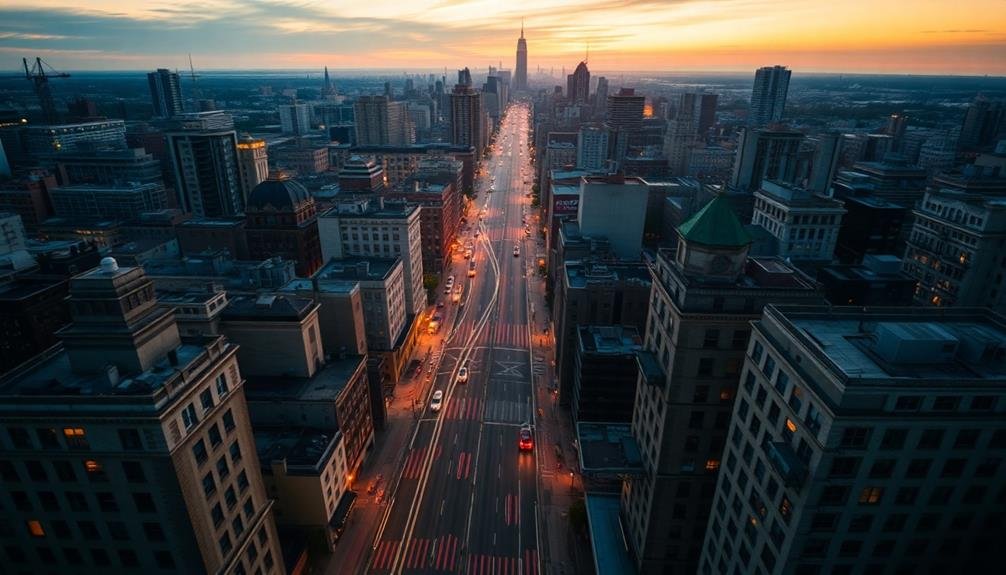
Once you've wrapped up your aerial shoot, the real magic begins in post-production. You'll need to apply specific techniques to enhance your aerial footage and create truly cinematic results.
Start by stabilizing your footage to eliminate any unwanted shakes or jitters. Use warp stabilizer in Adobe Premiere Pro or a similar tool in your preferred editing software.
Color grading is essential for aerial shots. Adjust the contrast, saturation, and white balance to create a cohesive look across all your footage.
Don't forget to correct lens distortion, which is common in wide-angle aerial shots. Apply lens correction filters to straighten curved horizons and fix warped edges.
Consider adding subtle motion to static shots using the Ken Burns effect or gentle zooms. This can add dynamism to otherwise still aerial views.
Experiment with speed ramping to create dramatic shifts between scenes. You can also enhance depth and dimension by adjusting the levels of foreground, midground, and background elements.
Drone Shot Planning and Storyboarding
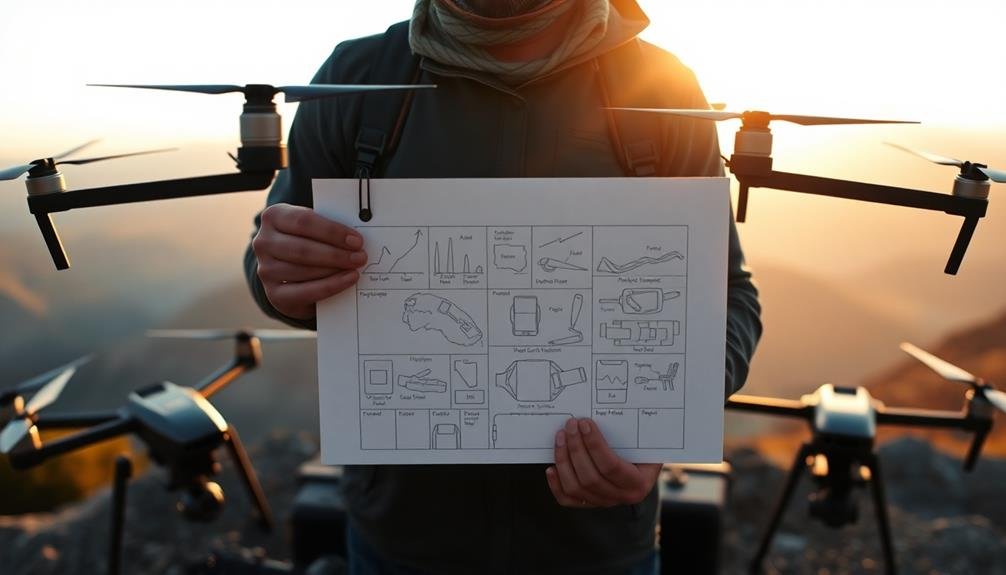
Before you launch your drone, it's essential to visualize your shots and plan your aerial scenes.
You'll want to map out the altitudes and movements for each shot, ensuring you capture the desired perspective and framing.
Pre-Flight Scene Visualization
A drone operator's success hinges on thorough pre-flight scene visualization. Before you even launch your drone, you'll need to mentally map out your shot sequence. This process involves imagining the entire flight path, considering obstacles, lighting conditions, and potential compositional elements.
To effectively visualize your drone shots, you'll want to:
- Walk the location, noting key features and potential hazards
- Sketch out a rough storyboard of your planned shots
- Use augmented reality apps to preview camera angles
- Create a mental timeline of the sun's position throughout your shoot
Altitude and Movement Mapping
Mapping out your drone's altitude and movement is essential for capturing stunning aerial footage. You'll need to plan each shot meticulously, considering factors like camera angle, flight path, and elevation changes.
Start by sketching your intended shots, noting key landmarks and focal points. Use this visual guide to determine the best altitudes for each segment of your flight.
As you plan, consider how changes in altitude can create dramatic effects. Ascending shots can build suspense, while descending shots often provide reveal moments.
Don't forget to factor in obstacles and no-fly zones that might affect your planned route. It's vital to map out smooth shifts between different altitudes and movements to maintain a professional look.
When plotting your drone's path, think about the story you're telling. Each movement should serve a purpose, whether it's revealing a landscape, following a subject, or creating a specific mood.
Use a combination of straight lines, curves, and orbits to add variety to your shots. Remember, the most effective aerial cinematography often combines multiple movements and altitude changes within a single take, so plan your flight patterns accordingly.
Legal and Safety Considerations
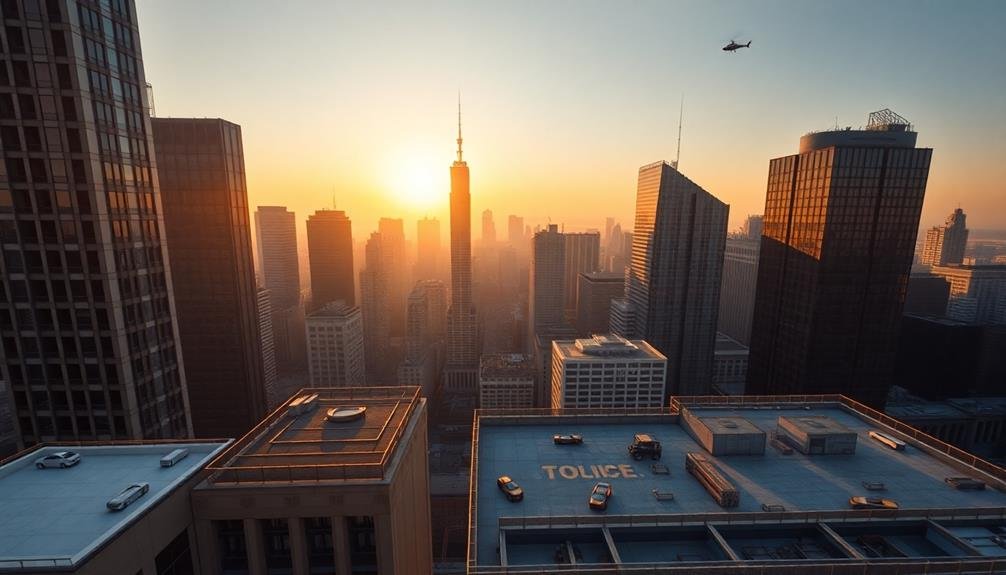
When capturing sky-high camera angles, three essential legal and safety considerations must be addressed.
First, you'll need to obtain proper permits and clearances for aerial filming in your location.
Second, make sure you're complying with local aviation regulations, including altitude restrictions and no-fly zones.
Third, prioritize the safety of your crew and equipment by implementing rigorous safety protocols.
To create truly cinematic sky-high shots, you'll want to:
- Scout locations thoroughly, identifying potential hazards and ideal filming positions
- Use high-quality, stabilized camera rigs designed for aerial use
- Employ experienced drone pilots or helicopter operators familiar with cinematography
- Conduct thorough pre-flight checks and rehearsals
Frequently Asked Questions
How Do Sky-High Camera Angles Affect Audience Perception of Characters?
You'll notice sky-high camera angles make characters appear small and vulnerable. They're dwarfed by their surroundings, emphasizing their isolation or insignificance. You'll feel a sense of power or detachment as you observe them from above.
What Are Common Mistakes to Avoid When Using Aerial Shots?
When using aerial shots, don't overuse them or rely on them solely for visual impact. You'll want to avoid disorienting viewers, neglecting storytelling, and forgetting about proper lighting. Also, make certain you're following local drone regulations and safety guidelines.
How Can Aerial Cinematography Be Effectively Incorporated Into Low-Budget Productions?
You can incorporate aerial cinematography on a budget by using drones, renting equipment, or finding elevated locations. Maximize limited shots through careful planning. Collaborate with local drone operators or film students to reduce costs and gain expertise.
Are There Specific Genres That Benefit Most From Sky-High Camera Angles?
You'll find sky-high angles excel in action, sci-fi, and disaster films. They're perfect for showcasing epic landscapes, grand-scale events, and futuristic cities. They'll also enhance documentaries, nature films, and establishing shots in various genres.
How Has the Evolution of Drone Technology Impacted Cinematic Aerial Photography?
You'll notice drone technology has revolutionized aerial cinematography. It's made sky-high shots more accessible and affordable, allowing filmmakers to capture stunning perspectives that were once impossible or prohibitively expensive. You're now seeing breathtaking aerial views in various productions.
In Summary
You've learned the key elements that make sky-high camera angles truly cinematic. From mastering altitude and movement to perfecting composition and lighting, you're now equipped to create stunning aerial shots. Remember to plan carefully, consider the environment, and stay within legal bounds. As you apply these techniques, you'll transform landscapes and tell powerful visual stories. Keep experimenting, and you'll soon be capturing breathtaking aerial footage that elevates your cinematography to new heights.

As educators and advocates for responsible drone use, we’re committed to sharing our knowledge and expertise with aspiring aerial photographers.
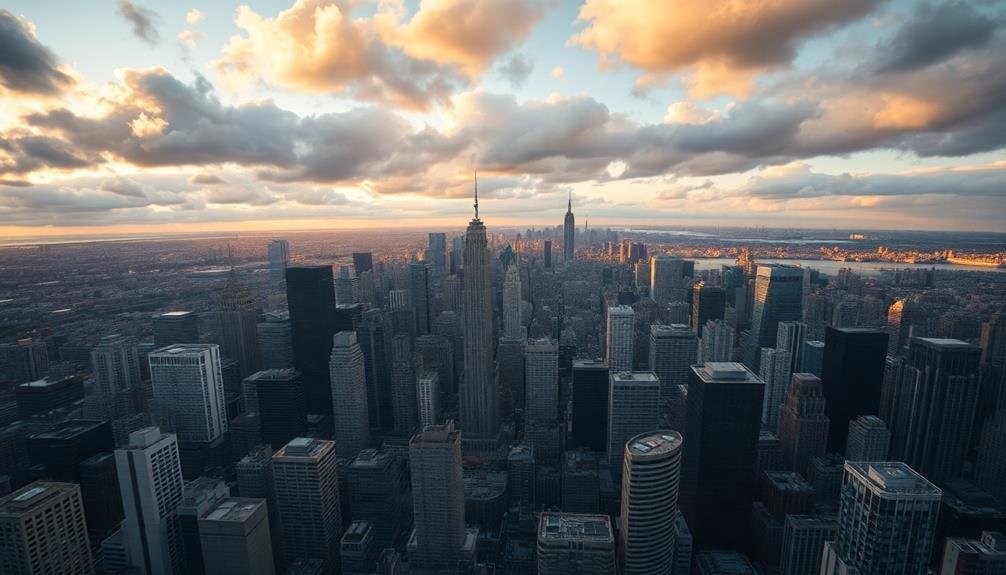



Leave a Reply